Savannah Lizards live near the end of a woodland, forest or at the edge of a desert. They are places where the environment transitions. These areas are sparse and may have periods during the year where there is more rain and vegetation. There are many types of lizards found in this sometimes harsh, but vegetated environment.
The terrarium should reflect this type of habitat. Note that many plants used in Savannah terrariums need to be periodically replaced. Substrate used at the bottom of any terrariums should be sandy humus and rocks. Plant life includes:
- acacias (seedlings)
- clumped grass areas
- branches
- cactus skeletons
Plants can be in pots. Use a cage with a screen top to keep humidity levels in the lizard cage, low. Note Savannah Lizards is the spelling used in the UK whereas Savannah is used in the U.S.
Savannah Lizard Species
- Savannah Geckos
- Helmeted Gecko
- Tokay Gecko
- Indonesian Skunk Gecko
- Australian Velvet Gecko
- New Caledonian Geckos
- Eyelash Geckos
- Curly Tailed Lizards
- Skinks
- Glass Lizards
- Alligator Lizards
- Girdle Tailed Lizards
- Plated Lizards
- Zonosaurs
- Lacertid Lizards
- Frilled Lizards
- Bearded Dragons
- RaceRunners
- Whiptail Lizards
- Savannah Monitor Lizards
Information on Savannah Lizards as Pets
Savannah Geckos
Savannah Geckos eat crickets that are powered with calcium. This supplement needs to be added to the diet 1x per week. They eat nectar. They will drink from a water dish, but these lizards must be misted every day. Keep plants in the terrarium moist to encourage Geckos to drink from the droplets.
- Helmeted Gecko (Geckonia chazaliae): This Gecko breed is native to the west coast of Africa and grows to 3 to 4 inches in length. These Geckos prefer daytime temperatures of 85F to 96 F (29C - 25.6C) and nighttime temperatures of 70F (20C). Will drink from a low water dish. Lizard feed for a helmeted gecko includes butterflies, crickets, cockroaches, mealworms and beetles. One month per year is the "winter rest" where the temperature is kept 10 degrees lower. They live in the desert as well as the Savannah.
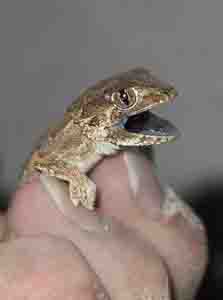 The Helmeted Gecko is a Savannah Lizard that is Bred for Captivity
The Helmeted Gecko is a Savannah Lizard that is Bred for Captivity
Source: Wikimedia, Gunilla
- Tokay Geckos (Squamata Gekkonidae): The Tokay Gecko is a nocturnal lizard that grows to 10 inches to 1 foot in length and will live 7 to 10 years. This Gecko is from Southeast Asia and the Malayan Isles. They are found in many types of environments including tropical and subtropical areas, mountainsides, rocky outcrops and in deserts. In the United States they are found in Hawaii and South Florida, and are found around buildings.
These types of savannah lizards are characterized by a green/gray color and spots that are orange/brown. The "Tokay" name is based on the loud call or noises made by the lizard.They eat other lizards, insects (crickets, wax worms, wax moths, super worms, locusts, butterworms), frogs and pinkie mice. These lizards can also vocalize and bite. Like other Geckos, they can climb walls. Tokay Geckos are nocturnal and are only for experienced lizard hobbyists since they do not like to be handled. Download this PDF for more information on the Tokay Gecko.
- Habitat: 10 gallon tank
- Temperature: 85F to 90F during the day, 15F at night
- Heat: Heat can be used. The Gecko requires 10 hours of light per day.
- Substrate: Potting soil and sand mixture, coconut fiber, fur bark, orchid bark
- Humidity: Requires 70% to 90% humidity
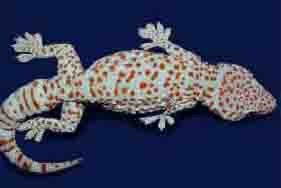 Tokay Gecko's make distinct noises that sound like its' name. They can change skin tone to blend into the environment. These Geckos are able to cling to surfaces, including the unique ability to walk upside down.
Tokay Gecko's make distinct noises that sound like its' name. They can change skin tone to blend into the environment. These Geckos are able to cling to surfaces, including the unique ability to walk upside down.
Source: Petco
- Indonesian Skunk Gecko: Kept in small 10 gallon terrariums, although more space is preferred. High terrariums are preferred, particularly in the dimensions of 48 inches long,x 30 inches wide, 66 inches high. Provide opportunities to climb.
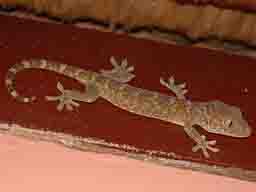 Indonesian Skunk Gecko
Indonesian Skunk Gecko
Source: Wikimedia, Humphrey Manusiwa
- Australian Velvet Gecko: These savannah lizards very active. Kept in a vertical 15 gallon tank. Terrarium temperature of 80 to 90F (26.7C - 32C) is preferred. Drink water drops from plants and perches.
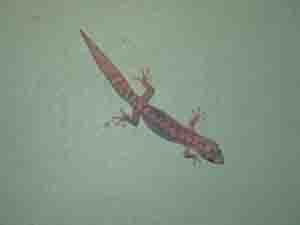 Australian Velvet Gecko
Australian Velvet Gecko
Source: Wikimedia, Peter Firminger
- New Caledonian Geckos or Eyelash Geckos as Pets: This is the type of Gecko commonly found in pet stores that sell savannah lizards. They grow to 8 inches. Caledonian Geckos feed on insects and fruit. The terrarium should be a 30 gallon tank (24 inches long x 12 inches wide x 2 inches high).
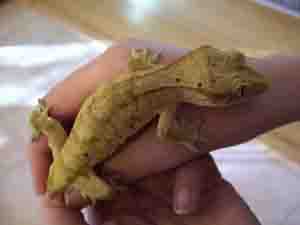 Female New Caledonian Crested Eyelash Gecko
Female New Caledonian Crested Eyelash Gecko
Source: Wikimedia, Margo226
- Curly-tailed Lizards: These savannah lizards are 6 inches to 10 inches long. They eat insects and some plants. The terrarium should be dry with a sand substrate for burrowing. They can dart on rock surfaces, which are preferred in the terrarium.
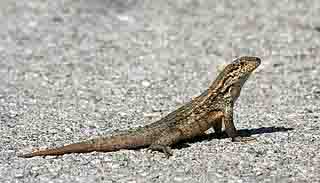 Curly Tailed Lizard
Curly Tailed Lizard
Source: Wikimedia, Lanare Sevi
- Skinks: This Savannah lizard is found in tropical and temperate regions. They can be a few inches to 2 feet in length. The terrarium should have a floor space of 36 inches x 24 inches and a height of 15 inches. 2 inches of each substrate plus dried leaves and small dried palm fronds. Also include a few layered rocks and limbs. They will drink from a low dish.
- Fire Skinks: same care as described above.
- Broad-headed Skinks: Do well on vitamin dusted insects. Will eat canned cat food.
- Larger Australian Skinks: Requires large enclosure with multiple rock piles.
- Spiny-Tailed Skinks: Will eat canned cat food. Requires large cages and rock piles.
- Pink Tongued Skink: Will eat fish flavored cat food.
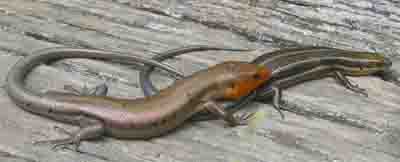 Pair of Savannah Skink Lizards
Pair of Savannah Skink Lizards
Source: Wikimedia, PFLY
- Alligator and Glass Lizards: These Savannah lizards superficially look like snakes and are legless lizards. Characteristics that separates them from snakes include external ear openings, small scales, movable eyelids. They grow in size between 18 inches to 42 inches long, most of which is tail (head to body grows to 12 inches). These lizards eat mostly insects (spiders, earthworms, snails). Hard to capture in the wild without breaking the lizard's tail. May bite a handler. They are called glass lizards due to the likelihood that the tail will break off if a predator grabs the tail. The glass lizard tail will keep on moving after it breaks off. This lizard's lifespan is 15 years. Download a Glass Lizard fact sheet here (PDF Download).
- Slow Worm Lizards: Eats insects such as slugs, earthworms, centipedes.
- Alligator Lizards: Kept in a dry substrate, and must have fresh water. Will eat canned cat food.
- Glass Lizards: Large size lizard that eats insects and mice. Will also eat cat food.
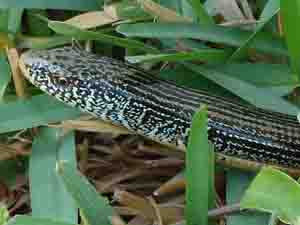 The Savannah Glass Lizard will break off if grabbed by a predator or human
The Savannah Glass Lizard will break off if grabbed by a predator or human
Source: Wikimedia, FI295
- Girdle Tailed Lizards: These savannah lizards are between 4 inches and 18 inches. They eat insects and some rodents. They will also eat leaves and blossoms. They will drink from water dishes. They prefer hot, dry, low humidity habitats.
- Sungazer: 13 inch long type of Girdle lizard.
- Armadillo Lizards: 4 to 6 inches in length. Feed on insects, like termites in particular.
Other types:
- Flat Lizards
- Warren Armadillo Lizards (Ouroborus cataphractus): Native to South Africa. Characterized by rows of sharp spines covering the back of the tail and can grow to 5 to 8 inches in length (150mm to 200mm). Found near termite mounds, their food source. For more information download this fact sheet on the Armadillo Girdled Lizard.
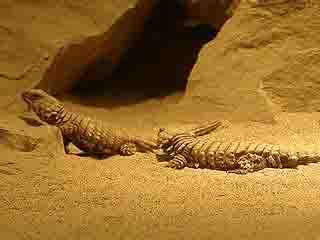 Girdle Tailed Lizards
Girdle Tailed Lizards
Source: Wikimedia
- Plated Lizards and Zonosaurs (Gerrhosaurus)
- Over time, these savannah lizards will get used to a handler and will become tame. They are originally from Southern and Eastern Africa. The name is from the thick scales on their body. Download this sheet on caring for plated lizards (PDF download).
Home Habitat:
- These Savannah lizards require 50% humidity
- Day temperatures are 90F with cool areas at 75F. Night temperatures should be 70F to 75F. Use a reptile heat mat for 24 hour ground heat in a terrarium.
- Basking areas are required on logs or rocks
- Furniture should include a hiding area, such as one made out of cork bark
- Substrate: Potting soil mixed with orchid bark or beech chips
- Clean the terrarium 1x per week using a 3% bleach solution (remove lizard before cleaning).
- Diet: These savannah lizards are plant and meat eating omnivores. Feed every day. Preferred foods include:
- Insects (crickets, locusts, mealworms, waxworms
- Rodents: Pinkie mice
- Fruit: Papaya, banana, strawberry, melon
- Plants: Dark greens, broccoli, spinach, carrots, turnips, dandelions (leaves, flowers), green beans, sprouts
- Provide a multi-vitamin supplement 1x or 2x a week
- Water: in dish changed every day
Species:
- African Plated Lizards Can live 10 or more years. Eat insects and some rodents, blossoms, vegetation.
- Zonosaurs (Malagasy Smooth scaled plated lizards): Topical lizards that also live in the forest. Rarely bask. Eat insects, anelids, canned cat food, canned dog food, fruit. Prefer daytime temperatures of 77F to 90F (25C to 32C).
 Four Lined Plated Lizard
Four Lined Plated Lizard
Source: WikiMedia
- Lacertid Lizards: Jeweled and Green Lacertas: These savannah lizards grow to 18 inches to 32 inches in length. Lacertid lizard diet is small insects, rodents and small birds. Will eat fruit and blossoms. Require large cages since they like to move and climb.
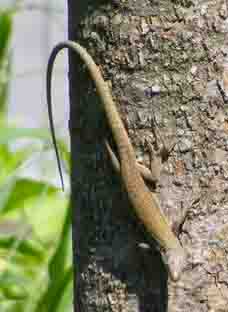 Lacertid Lizard Climbing Tree
Lacertid Lizard Climbing Tree
- Frilled Lizards (also called Frilled Dragons) and Bearded Dragons:
These are big 32 inch lizards. Adapt well to captivity.
Frilled Lizards:
- Origin is Australia and New Guinea
- Named for the "frill" around the neck, the frill can expand to 14 inches
- The Frilled Dragon can grow to 3 feet long
- These lizards primarily eat insects, but will eat small rodents and birds.
- Diet: Omnivore that requires 70% insects (gut loaded or recently fed crickets, mealworms, was worms), 30% mixed fruits and vegetables, sprinkle food with a calcium supplement
- Lizard Feeding Schedule: 3x to 5x per week, younger lizards are fed every day
- For babies, 20 gallon terrariums are fine. Adult lizards require an enclose that is no smaller than 75 to 100 gallons (378.5L) or 4 ft square/wide x 3 feet high
- Temperature: Warm basking area of 100F, cool area not less than 70F. Supply radiant heat using a ceramic heater or incandescent light bulb.
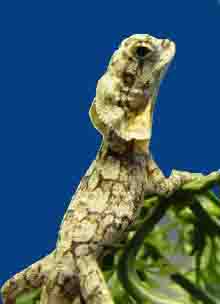 Frilled Lizard
Frilled Lizard
- Bearded Dragons (pogona vitticeps):
- Native to central Australia, beard refers to skin slap under the chin. Skin flap expands when disturbed.
- Can make excellent pets
- Can grow to 15 inches to 2 feet in length
- Tolerates human interaction.
- Grows to 12 to 18 inches
- Lizard lifespan is 7 to 10 years
- Habitat: 75 or 120 gallon tank is best. Measurement should be 48 in x 24 in x 18 in high.
- Substrate: Do not use sand or small particles. Best choice is newspaper, repti-carpet or sterile potting soil.
- Lighting: UVB light from a fluorescent bulb that has at least 5% UVB. Bulb should be more than 12 inches from basking area. Provide 10 hours of light and 14 hours of darkness per day.
- Temperature: Daytime is 80F-85F. Basking area is is 88F to 95F. Night temperature is 70F - 75F. Under tank heater can maintain minimum night temperature if necessary.
- These lizards like to bask in the sun to generate heat.
- Diet (Omnivorous, insect/meat, plant): Feed a varied diet.
- Plants/Vegetables: Pumpkin, winter squash, snow peas, turnips, sweet potatoes, lentils, green beans, carrots, butternut squash, green bell pepper, red bell pepper, acorn squash
- Occasional Feed: Cabbage, kale, chard, spinach, broccoli, parsley
- Fruit, no seeds or pits: apples, apricot, banana, berries, cantaloupe, figs, grapes, mangoes, oranges, papaya, peach, pear, plum, tomatoes
- Insects (70% of diet): Gut loaded (pre-fed) crickets, mealworms
- Juveniles require Require calcium supplements (no phosphous or vitamin D) 3x per week, and a reptile multivitamin 1x per month
Download this free fact sheet on bearded dragon care from USC (PDF Download).
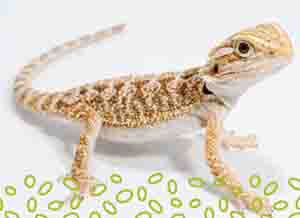 Bearded Dragon Savannah Lizard
Bearded Dragon Savannah Lizard
Source: Petco
- RaceRunners and Whiptail Lizards (also called Jungle Runners): The Racerunner and Whiptail savannah lizards are very nervous and will run away from any threat
- Must be in a warm environment with a basking area at 105F, hiding areas, dry substrate
- Will eat a variety of foods
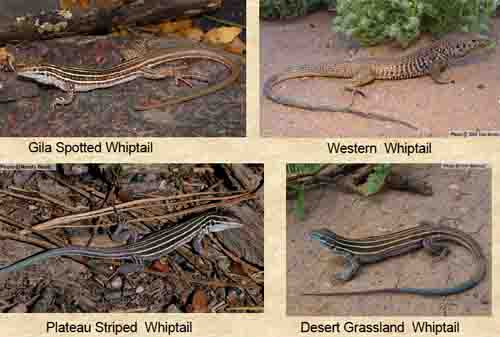 Whiptail Lizards
Whiptail Lizards
Source: US Forestry Service
The African Savannah Monitor (varanus exanthematicus) is a popular lizard and can be found in many pet stores. The lizard is native to Sub-Saharan Africa and north of the Congo River. It is gray in color with markets and tough scales. The lizard is stocky in appearance and grows to 2.5 to 4 feet in length (1.52m) - 5 feet is rare, depending on the type of Savannah monitor lizard.
- The Savannah monitor lizard can puff up its body when threatened. When they do this they are preparing to lash the threat with their tail. They also have claws and the ability to create a bad odor in defense.
- Habitat: As a large lizard, the cage will need to be at least 6 ft. x 6 ft. x 10 ft. (1.83m x 1.83m x 3.05m). Do not use wire mesh, preference for glass or Plexiglas to maintain humidity
- Substrate: Use a deep 2 foot substrate such as dirt. The monitor likes to create tunnels and burrows.
- Temperature: Cool size of lizard cage between 75F to 80F. heated area to 90 to 100F. Basking area heat to 11`0 to 130F. Night temperature can fall to room temperature. Heat basking area with rack of 3 to 4 flood lamps at 60 to 120 watts.
- When held in captivity for many years they can become overweight, and may require that food be limited.
- Lizard lifespan is 10 to 15 years
- Diet: Insects (large roaches), small rodents. Feed a variety of foods daily.
- Supplements: Dust insects with vitamin and mineral powder
Click here to download a summary of Savannah Monitor Care (PDF Download).
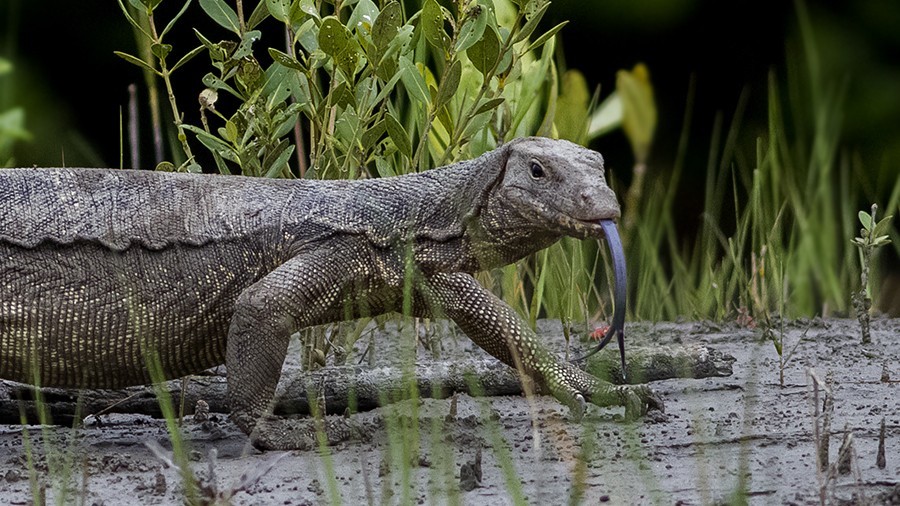 Savannah Monitor Lizard
Savannah Monitor Lizard
Have a Lizard Related Question for our Vet? We Will Answer it for Free!
Do you need some pet lizard advice? Just ask a question and our Vet will answer it as soon as possible.
If your question is medical or behavior-related, please include information such as species, age, diet, habitat, and anything related to the medical history of your lizard.
Please upload a picture of your lizard, especially if you believe it will help the Veterinarian. Please know that we receive many questions and answer them on a first-come, first-served basis. If you need an immediate response, we suggest you use this online veterinary service that is available now to answer your questions.